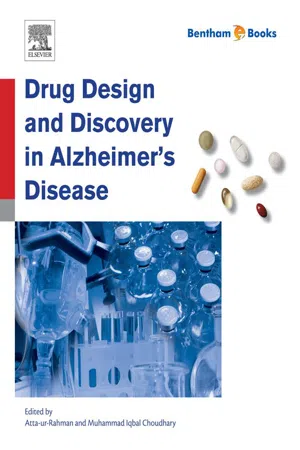
Drug Design and Discovery in Alzheimer's Disease
- 784 pages
- English
- ePUB (mobile friendly)
- Available on iOS & Android
Drug Design and Discovery in Alzheimer's Disease
About This Book
Drug Design and Discovery in Alzheimer's Disease includes expert reviews of recent developments in Alzheimer's disease (AD) and neurodegenerative disease research. Originally published by Bentham as Frontiers in Drug Design and Discovery, Volume 6 and now distributed by Elsevier, this compilation of the sixteen articles, written by leading global researchers, focuses on key developments in the understanding of the disease at molecular levels, identification and validation of molecular targets, as well as innovative approaches towards drug discovery, development, and delivery. Beginning with an overview of AD pharmacotherapy and existing blockbuster drugs, the reviews cover the potential of both natural and synthetic small molecules; the role of cholinesterases in the on-set and progression of AD and their inhibition; the role of beta-site APP clearing enzyme-1 (BACE-1) in the production of ß-amyloid proteins, one of the key reasons of the progression of AD; and other targets identified for AD drug discovery.
- Edited and written by leading experts in Alzheimer's disease (AD) and other neurodegenerative disease drug development
- Describes existing drugs for AD and current molecular understanding of the condition
- Reviews recent advances in the field, including coverage of cholinesterases, BACE-1, and other drug development targets
Frequently asked questions
Information
Pharmacotherapy of Alzheimer’s Disease: Current State and Future Perspectives
b University Hospital Hradec Kralove, Sokolska 581, 500 05 Hradec Kralove, Czech Republic
c University of Hradec Kralove, Faculty of Science, Department of Chemistry, Rokitanskeho 62, 50003 Hradec Kralove, Czech Republic
d Centre of Advanced Studies, Faculty of Military Health Sciences, Trebesska 1575, 500 01 Hradec Kralove, Czech Republic
Abstract
1 Alzheimer’s Disease - Historic Overview
2 Current Status and Prevalence of AD
3 Risk Factors for AD
Table of contents
- Cover image
- Title page
- Table of Contents
- Copyright
- Preface
- List of Contributors
- Chapter 1: Pharmacotherapy of Alzheimer’s Disease: Current State and Future Perspectives
- Chapter 2: Challenges in Designing Therapeutic Agents for Treating Alzheimer’s Disease-from Serendipity to Rationality
- Chapter 3: Enzyme Inhibitors Involved in the Treatment of Alzheimer’s Disease
- Chapter 4: Towards Small Molecules as Therapies for Alzheimer’s Disease and Other Neurodegenerative Disorders
- Chapter 5: Multifunctional Enzyme Inhibition for Neuroprotection - A Focus on MAO, NOS, and AChE Inhibitors
- Chapter 6: Specific Cholinesterase Inhibitors: A Potential Tool to Assist in Management of Alzheimer Disease
- Chapter 7: Role of Acetylcholinesterase Inhibitors and Alzheimer Disease
- Chapter 8: Research Strategies Developed for the Treatment of Alzheimer’s Disease. Reversible and Pseudo-Irreversible Inhibitors of Acetylcholinesterase: Structure-Activity Relationships and Drug Design
- Chapter 9: Modulation of BACE1 Activity as a Potential Therapeutic Strategy for Treating Alzheimer’s Disease
- Chapter 10: BACE1 Inhibitors: Attractive Therapeutics for Alzheimer’s Disease
- Chapter 11: Combining BACE1 Inhibition with Metal Chelation as Possible Therapy for Alzheimer’s Disease
- Chapter 12: Somatostatin Receptor-4 Agonists as Candidates for Treatment of Alzheimer’s Disease
- Chapter 13: Neprilysin Inhibitors Provide Insight into its Specificity and Therapeutic Potential
- Chapter 14: Targeting the GSK3β/β-catenin Signaling to Treat Alzheimer´s Disease: Plausible or Utopic?
- Chapter 15: Targets and Small Molecules Against Tauopathies. Part 1: From Genes to Soluble, Aggregation-Prone Tau Proteins
- Chapter 16: Nanomedicine Based Drug Targeting in Alzheimer’s Disease: High Impact of Small Carter
- Index